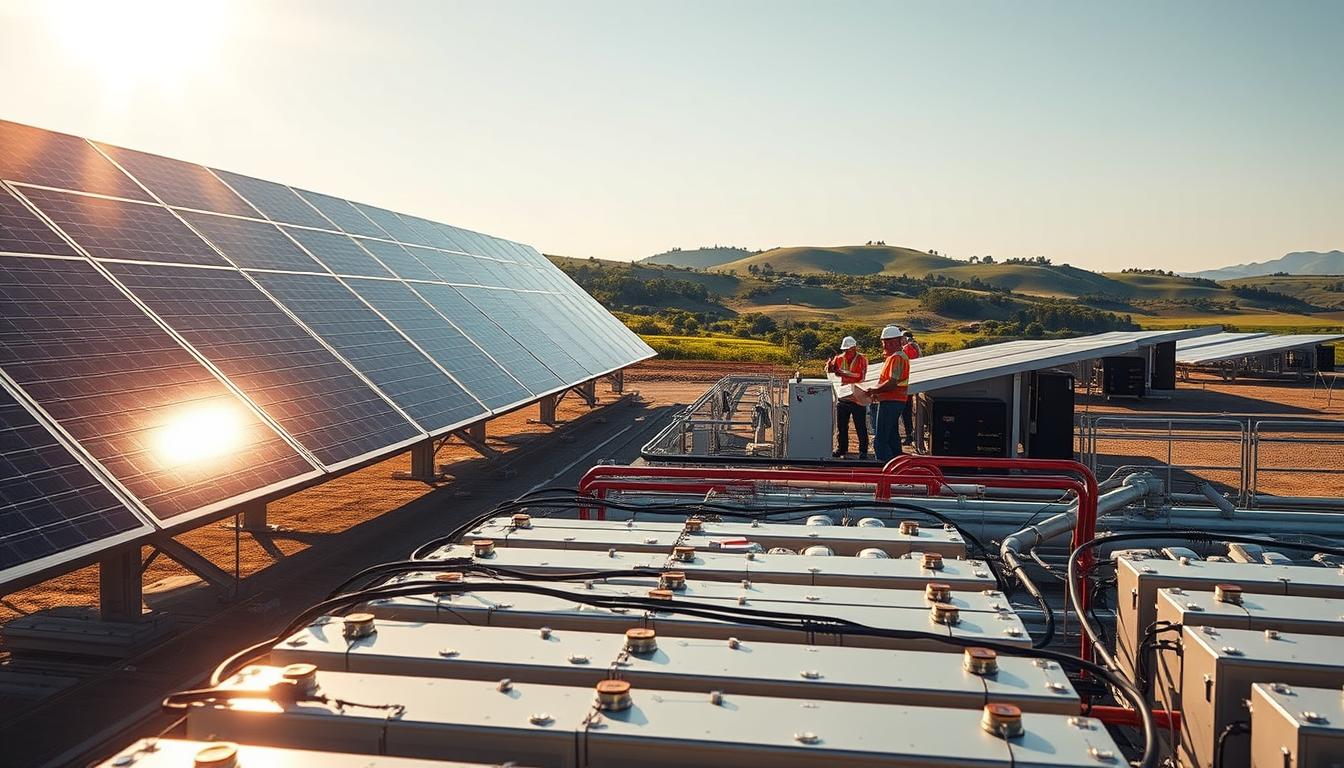Did you know that the amount of solar energy the Earth receives in just one hour is enough to power the entire world for a year? However, harnessing this energy efficiently remains a significant challenge. The main issue with solar energy is its intermittency; solar panels generate electricity during daylight hours but not when the sun isn’t shining.
To address this challenge, we need effective energy storage solutions. By capturing excess energy during peak production times, we can use it during evenings or cloudy days, thereby balancing supply and demand.
We will explore various storage systems that enable homeowners and businesses to maximize their solar energy investment. From traditional battery storage to innovative alternatives, understanding these options is crucial for making informed decisions about energy storage.
Understanding the Need for Solar Energy Storage
Solar energy has become a vital part of our renewable energy mix, but its intermittent nature poses a substantial challenge. Even the most ardent solar evangelists can agree on one limitation solar panels have: they only produce electricity when the sun is shining. This characteristic creates a mismatch between energy production and consumption patterns.
The Solar Energy Challenge
The fundamental mismatch between solar energy production and household energy consumption patterns is a significant issue. Solar panels generate maximum power during daylight hours, while most homes use peak energy in the evenings. As Mark Jacobson, a professor of civil and environmental engineering at Stanford University, once said,
“To truly transition to a renewable energy future, we need to address the variability of renewable energy sources.”
This variability is at the heart of the solar energy challenge.
During the day, especially around midday, solar panels often produce more energy than households need, resulting in surplus electricity. This excess energy is not utilized effectively if it’s not stored properly. The challenge, therefore, is to capture this excess energy during production periods for later use.
Balancing Supply and Demand
Effective energy storage systems are crucial for balancing the supply and demand of solar energy. By storing excess energy generated during the day, households can use it during peak hours in the evening, thereby reducing their reliance on the utility grid during non-production periods. This not only enhances energy independence but also ensures a consistent energy supply throughout the year, regardless of weather variability or seasonal changes.
Weather variability and seasonal changes significantly affect solar production. For instance, during winter months or on cloudy days, solar panels produce less energy. Energy storage solutions can mitigate these fluctuations by storing surplus energy from sunny days or summer months for use during periods of low solar production.
By transforming intermittent solar power into a reliable, on-demand energy source, energy storage plays a pivotal role in maximizing the benefits of solar energy. It bridges the gap between peak solar production hours and peak household energy consumption times, ensuring that households can rely on solar energy when they need it most.
Key Benefits of Solar Energy Storage Methods
Solar energy storage is a game-changer for both homeowners and the environment, offering a multitude of benefits that enhance the value of solar panel installations. By storing surplus energy generated during the day for use at night or during power outages, solar energy storage systems provide a reliable and efficient way to maximize the benefits of solar energy.

Energy Independence and Resilience
One of the primary benefits of solar energy storage is the ability to achieve true energy independence. By allowing homeowners to rely less on utility companies, especially during power outages or grid failures, solar energy storage systems provide a level of energy security that is invaluable. This independence is further enhanced by the resilience that energy storage creates against utility rate increases, power outages, and grid instability, providing peace of mind and a consistent power supply.
Cost Savings and Economic Benefits
The economic benefits of solar storage are significant. By reducing grid consumption and allowing homeowners to use stored energy during peak rate periods, solar energy storage can lead to substantial savings on electricity bills. For homeowners in areas with time-of-use billing or without net metering, storage can significantly improve the financial return on solar investments, making solar energy an even more attractive option.
Environmental Impact and Carbon Footprint Reduction
Maximizing self-consumption of solar energy through storage further reduces carbon footprint beyond what solar panels alone can achieve. By replacing fossil fuel-based backup power systems like generators with stored solar energy, we can eliminate emissions and noise pollution. Moreover, energy storage contributes to grid stability and efficiency, potentially reducing the need for new fossil fuel power plants to meet peak demand, thus creating a more complete clean energy solution.
Battery Storage Systems: The Most Common Solution
Battery storage systems have emerged as the most viable solution for storing solar energy. These systems store excess energy generated by solar panels during the day for use during the night or on cloudy days, thereby ensuring a stable and reliable energy supply.
Lithium-Ion Batteries: Efficiency and Longevity
Lithium-ion batteries have become the industry standard for solar energy storage due to their high energy density and long lifespan, typically lasting between 10 to 15 years. They offer excellent depth of discharge and require minimal maintenance, making them a preferred choice for residential and commercial solar installations.
Lead-Acid Batteries: Budget-Friendly Options
For those on a tighter budget, lead-acid batteries present a more affordable upfront cost. However, they have a shorter lifespan and lower depth of discharge compared to lithium-ion batteries. Regular maintenance is also necessary to ensure their longevity.
Flow Batteries: Emerging Technology
Flow batteries represent an emerging technology in the solar energy storage sector. They offer scalable capacity and a longer cycle life, with the ability to fully discharge without damaging the battery. This makes them particularly suitable for certain applications where these features are beneficial.
A comparison of these battery technologies across key metrics is essential for determining the most suitable option. The following table summarizes the main characteristics of each battery type:
| Battery Type | Cost per kWh | Cycle Life | Efficiency | Maintenance Requirements |
|---|---|---|---|---|
| Lithium-Ion | Moderate to High | 10-15 years | 85-95% | Low |
| Lead-Acid | Low | 5-7 years | 70-80% | High |
| Flow Batteries | High | 15+ years | 80-90% | Moderate |
When selecting a battery storage system, it’s crucial to consider factors such as space requirements, temperature sensitivity, and integration with existing solar systems. Additionally, a battery management system plays a vital role in optimizing performance and protecting the battery investment.
Alternative Solar Energy Storage Methods
Beyond batteries, various innovative methods are being developed to store solar energy efficiently, catering to diverse needs and applications. These alternative storage solutions are crucial for enhancing the reliability and flexibility of solar energy systems, particularly for larger-scale or specialized energy storage needs.
Thermal Energy Storage Systems
Thermal energy storage systems capture excess solar energy as heat in various mediums such as molten salt, water, or phase-change materials. This stored heat can later be converted back into electricity or used directly for heating purposes. Concentrated solar power plants utilize thermal storage with molten salt to continue generating electricity for hours after sunset, providing dispatchable renewable energy. Thermal energy storage is particularly effective for large-scale solar power generation.
Mechanical Storage Solutions
Mechanical energy storage takes advantage of the potential energy of an object to generate electricity. This is achieved by converting surplus electrical power into mechanical power, which is then converted back into electricity when needed.
Pumped Hydro Storage
Pumped hydro storage is a proven technology that uses excess solar energy to pump water uphill to a reservoir. When energy is needed, the water is released through turbines to generate electricity. This method is highly effective for large-scale energy storage.
Compressed Air Energy Storage
Compressed air energy storage systems use solar electricity to compress air in underground caverns or tanks. The compressed air is later released through turbines to generate electricity during peak demand periods, providing a reliable and efficient storage solution.
Flywheel Energy Storage
Flywheel energy storage systems convert electrical energy into kinetic energy by spinning a mass. This kinetic energy is then converted back into electricity when needed, providing rapid-response storage that is particularly useful for grid stabilization and power quality applications. Flywheel energy storage offers a unique combination of high power density and long lifespan, making it suitable for applications requiring frequent charge-discharge cycles.
Residential vs. Commercial Solar Storage Applications
As we explore the realm of solar energy storage, it’s crucial to understand the different applications for residential and commercial settings. Solar energy storage systems are not one-size-fits-all; they vary based on the scale, technology, and specific needs of the user.
Home Solar Battery Systems
For homeowners, solar battery systems offer a cost-effective way to store excess energy generated by their solar panels. These systems typically range from 5-20kWh in capacity and are designed to power essential home circuits during outages or shift energy use to reduce utility bills.
When selecting a home solar battery system, homeowners must consider factors such as ease of installation, aesthetic considerations, safety, and integration with home energy management systems.
Some key considerations for home solar battery systems include:
- Ease of installation and maintenance
- Aesthetic appeal and compatibility with existing solar panels
- Safety features such as thermal monitoring and automatic shutdown
- Integration with home energy management systems for optimized energy use

Large-Scale Commercial Storage Solutions
Commercial solar storage solutions, on the other hand, are designed for larger-scale energy storage needs, often ranging from 50kWh to several MWh. Businesses implement these systems to reduce demand charges, participate in peak shaving, provide grid services, and ensure resilience during outages.
Commercial installations often incorporate sophisticated energy management systems that can respond to utility signals and participate in demand response programs.
| Application | Residential | Commercial |
|---|---|---|
| System Capacity | 5-20kWh | 50kWh – several MWh |
| Primary Use | Backup power, time-of-use optimization | Demand charge reduction, peak shaving, grid services |
| Energy Management | Basic integration with home energy systems | Sophisticated energy management systems |
By understanding the different needs and applications of residential and commercial solar storage, we can better appreciate the versatility and potential of solar energy storage systems.
Conclusion: Maximizing Your Solar Investment with Efficient Storage
Maximizing our solar investment requires more than just panels; it demands efficient energy storage solutions. Throughout this article, we’ve explored various methods to store solar energy, from battery storage systems to thermal energy storage. The right storage solution depends on specific needs, budget constraints, and application requirements. As storage technologies continue to advance and costs decline, pairing solar with storage becomes increasingly compelling. Emerging trends include smart energy management systems that optimize storage use based on weather forecasts and electricity rates. To maximize self-consumption and energy independence, combining solar generation with efficient storage is key. This not only provides the greatest return on investment but also contributes to a more resilient energy grid. As the energy landscape evolves, solar energy storage will become an essential component of solar energy systems.


Leave a Reply